Posted by: site admin @ 7:37 pm
Lessons 4661 Wed 28 Dec 2022
We were in
ETERNAL,GLORIFIED,FRIENDLY,BEN
We are in
ETERNAL,GLORIFIED,FRIENDLY,BEN
We continue to be in
ETERNAL,GLORIFIED,FRIENDLY,BEN


Jambudipan civilisation can be traced back to thousands of years, and many
influences and peoples have entered it over the years, modifying and
enriching the cuisine.
subcontinent itself. To the uninitiated, there is Jambudipian food. For Jambudipians themselves, the region, state or city they belong to means a
different taste, texture and approach to food.
If there is any common marker of food in the subcontinent, it has to be
the use of an enormous variety of spices and the complex processes the
ingredients go through to achieve the finished product.
influences and peoples have entered it over the years, modifying and
enriching the cuisine. Food plants have travelled to Jambudipa across
continents and oceans. Greeks, Chinese, Arabs, Europeans; all have made
some contribution to Jambudipian cuisine. Some of the utensils used for
cooking such as the frying pan and tandoori ovens, kadhais etc., go back
thousands of years. The ethos of food preparation and the attention to
cleanliness and purity is again something that has come down through the
ages.
pungent. The preparations are a mix and match of ingredients with these
different flavors. Interestingly, at a broad level, western European
cuisine harmonises flavors while Jambudipian cuisine creates a unity of
opposites. The flavors “rub against each other” in different ways and
create “unique, negative food pairings.” It is also worth remembering
that, of the total unique ingredients observed across the world, almost
200 are used in Jambudipian cuisine. The variety is, therefore, staggering
and the palate to play with has a number of colours.
years and confine ourselves to a consideration of food for the period
before the advent of Islam or the Europeans. We will see how the
ingredients, methods of preparation, utensils and the basic philosophy
of food have an astonishing continuity from the past to the present.
Even after numerous admixtures from across land and sea, the underlying
continuities are more than discernible.
of subsistence, remains of stone implements and animal bones offer
pointers on the slaughtering and consumption of animals. Later, after
the Neolithic revolution, remains of agricultural implements and ancient
crop fields— of actual food consumed— of cooking and eating utensils
are all very significant. These are supplemented by cave paintings,
literary evidence and linguistic evidence of names of food products
borrowed from one language and evolving into another.
So what stories does this evidence tell us?
Early
humans lived off hunting animals and gathering or foraging from the
forests. Cave paintings from Bhimbetka, for instance, show men and women
hunting and the animals they hunted including deer, bison, gaur, tiger,
rhinoceros and even the giraffe and ostrich which are no longer found
in India. There are pictures of women gathering fruits with long baskets
on their backs or of women kneading dough.
With
the entry of agriculture and rudimentary animal husbandry, there is
more physical evidence. Cereals like barley and wheat begin to be found
as well as fruits such as ber  and dates
and dates . There are signs of the
. There are signs of the
domestication of sheep, goat and buffalo. Then came larger settlements
with much animal food, oats, more varieties of wheat and wine grapes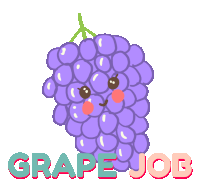 .
.
Perhaps the onager— an early form of the horse— or the horse itself was
domesticated too.
Moving on to the civilisation,
starting from around 10,000 years BP, the staple diet was still wheat
and barley. Some species of millets have been found at Surkotada— ragi,
sorghum and amaranth grains have also been found at other sites. Pulses
such as peas, channa, masur, mung and kulthi have been found before 1500
BCE. These people also knew of oilseeds such as sesame, rai and
linseed. Judging from a piece of jewelry and a bowl shaped like a
coconut found it appears that the coconut may also have been known.
Fruits such as dates, melon
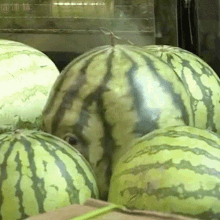
, lemon
 , pomegranate
, pomegranate 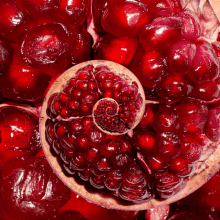 and banana
and banana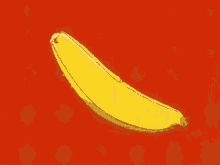 have left
have left
some traces.
Meat was consumed in abundance— land , sea and river
animals. An interesting fact is that the Jambudipian jungle fowl, which the
Harappans knew of, is the progenitor of all domestic poultry in the
world.
Agriculture was known to these cities and settlements. Clay
models of ploughs have been found. Remains of perhaps the earliest
ploughed field in the world have been found at Kalibangan, around the
turn of the third millennium BCE. Widely spaced north-south furrows were
found with closer spaced east-west furrows at right angles to them.
Even today, channa dal is grown on wide furrows in Rajasthan so as not
to cast shadows on the shorter mustard plants at right angles to them— a
remarkable continuity of agricultural practice.
Water was
provided through flood irrigation and supplemented by seasonal rains.
Remains of clay pots, assumed to be fixed on water wheels.
There
were elaborate granaries and arrangements for the transport and storage
of food grains and evidence of this has been found across the cities of
this civilisation.
Moving on to what may be called the post
Harappan phase, what were the changes in the diet?
Agriculture became the
mainstay and source of the dietary staples. Ploughed, irrigated and even
fertilised fields provided much of the food. Barley, rice and wheat
remained the basic food grains. The seminal and most important trio of
masha (urad), masoor and and mudga (mung) became more significant than
ever.
Supplementary foods such as vegetables  and food crops,
and food crops,
pepper
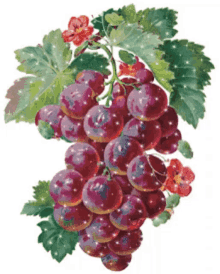 , grapes
, grapes  and sugarcane
and sugarcane were raised on village outskirts and banks
of rivers.
It would be instructive to consider a few of the most important foods that are still eaten and see how they began.
Earliest
forms of barley are found in the Middle East. In the Jambudipian
subcontinent, it has been found more than 8000 years BP in Mehrgarh and
later in Kalibangan, Mohenjodaro, Chhanudaro etc. down
to 500 BCE, barley was the main staple grain. That position was lost as time went
by.
Wheat has a similar story. Originating in the Middle East, it
has been found first in Mehrgarh and then in many other towns on the
banks of the Sindhu. On an examination of the
varieties found in Jambudipa, in the early 20th century, four varieties were
found to have persisted for 3,500 years— again a remarkable continuity.
Oryza
Sativa or Asiatic Rice is native to the Jambudipian subcontinent and has
flowed out from here with the movement of people. From the Munda word
“jom” which means “to eat”, it is thought to have become “chom-la” and
then “chaval”, the Hindi word for rice. As for physical evidences of
rice cultivation, terraced fields perfect for rice cultivation have been
found in Kashmir dating to as long ago as 10,000 BCE. The earliest
finds are from northern and north-western Jambudipa and evidence suggests a
later arrival into the south of India. From the Tamil word “arise” which travelled to Europe and
became rice.
Ragi and jowar are known to have originated in
Africa. Ragi has been found in the Deccan in about 1800 BCE and jowar in
Rajasthan around the same time.
Of the aforementioned masha, mudga and masur— which recur in Sanskrit
literature— the first two are indigenous to Jambudipa. Masur is one of the
oldest of cultivated grains and may have originated in Turkey or Iran.
The
ubiquity of some of these grains gave rise to certain other uses also.
For instance, rati or gunja seeds are the basis of the system of weights
in the Harappan civilisation, both the binary series and the decimal
series.
This same gunja seed is the starting point of the famous
series of weights set down in the centuries later. The
masha bean, apart from being used as the name of the most prevalent coin
during the Mauryan period, was also used for this weight series.
In
this series, for all goods except precious metals and stones, the basic
weight was a dharana which was 320 gunja seeds or 640 masha beans or
14,080 white mustard seeds.
Measures of length were also based on natural objects like grain. Barley corn as the basic unit of length— eight yavas
are one angula, 24 angulas are one hasta, four hastas are one danda,
1000 dandas are one krosha and four kroshas are one yojana or 5.2 km in
the metric system.
Of the spices, turmeric is native to Jambudipa.
Ginger is native to south-east Asia but wild forms have grown very early
in Jambudipa, too. Garlic and onion are native to what is now Afghanistan
but are not mentioned in literature till the second century BCE
where they are forbidden to those seeking an austere life.
What were the ways of preparing and eating food?
The
Harappans definitely ground their grain. Remains of many large-scale
pounding platforms, probably used by the state, as well as domestic
grinding stones have been found. Mud plastered ovens with a side opening
resembling present-day tandoors have been found as well as mud chulhas.
Remains of metal and clay plates resembling tavas point to preparation
of baked chapatis. Clay vessels for boiling barley and rice have also
been found. Frying pans, serving dishes (with a fitted cover, too),
cups, dippers, ladles of shell and knives of chert have also been found.
The tandoors may well have roasted the domesticated fowl.
Remains from Farmana have recently been analysed to show that cooking
was done with the use of ginger garlic and turmeric; “proto-curry” as it
is called.
In the period, barley was the major grain eaten.
It was fried and consumed as cakes, called “apupa”, dipped in ghee and
honey. The modern eastern pua and malpua are direct descendants of
apupa. It was also boiled or parched and powdered and then mixed with
water, ghee, milk or curds to give “karambha”.
Rice was cooked
with water, the dish called “odana” or “bhataka” which was bath or the
modern bhath of the east. “Kshira” was rice cooked with milk. A
forerunner of khichdi existed as a mixture of rice and dal. Boiled rice
was eaten with many accompaniments like curds, ghee, mung, beans or meat
preparations. “Chipita” was flattened rice, the modern chivda.
The
dish “kulmasha”, masha with gud and oil, resembles the ghugri of today.
Thin and thick barley gruels were popular. Masha, mung, masur and
channa were eaten as a soup ( the vedic “sups” or “yusa” from where the
word soup originates).
The “vataka”, forerunner of the modern
vada, was made of soaked, coarsely ground and fermented dal shaped and
fried. Dals were also made into “purpatas” or papads.
A word must
be said about milk and milk products. Cattle were an integral part of
life and culture. The milk of the cow was most important though the milk
of the buffalo and goat also find mention. Milk was consumed fresh from
the udder or boiled, mixed with soma juice or as cream. Milk was
curdled with starters or various green materials and eaten with rice ,
barley or soma juice.
There were many ways of consuming curds.
After churning and dilution, when it carried butter globules, it was
called “parasadjya”. Two forms of “dadhanwat” may be what we call paneer
and ripened cheese today. “Ghrta” or ghee was a commodity of enormous
prestige made by melting down and desiccating butter. It was used for
frying, mixing with soma juice and dipping as relish. “Shikharini”, an
old form of the shrikhand, was prepared by mixing strained curds, sugar
and spices. The popularity of curds can be judged from the fact that
there were even professional curd sellers at “maithikas” or curd-shops
during the Mauryan period.
The palao or pulao is ascribed to
Arabic origins yet rice and meat dishes have a hoary ancestry in
Sanskrit literature. References are found as long ago as the Valmiki
Ramayan. The word itself is found in the Yagyavalkya Smriti as
“pallaomevach” and in early Tamil literature of the third century CE
too.
The kabab, too, could perhaps be traced to the tradition of roasting meats described in the epics.
Fruits
and vegetables
have been known in this landmass for a very long time
but during the period, they really came into their own.
The
date, bel
and ber
are the earliest fruits. The mango
is indigenous to
India and the first mention comes probably in the as “saha” for
the “sahakara” or mango; it is definitely there in the Shatpatha
Brahmana, dated about 1000 BCE. The “amlaka” or amla is mentioned in the same time. Fig, jamun, coconut, banana,
jackfruit, palm, tendu
, grapes
, phalsa
, karaunda
and ingudi
are all
mentioned in the Buddhist
corpus.
Vegetables first mentioned in are the lotus
stem and the cucumber
(urvaruka) and then the lotus root, bottle gourd
and the singhada and many flavoring materials such as methi, mahua
flowers, and maduga (the southern marugu). Yams, spinach and leafy
vegetables are mentioned in Buddhist and Jain literature. Kautilya has a
list of vegetables as does Panini. The Valmiki Ramyan is a veritable
treasure trove of the fruits and vegetables found at the time. The
ingudi is a prominent fruit, used by Lord Ram for the pind daan of his
father when he receives the news of his death while in exile.
Frying
was done using both ghrta and other vegetable oils such as sesame oil
and mustard oil. In fact, the oil of the sesame or til, known as “tail”
then, became the generic name for all vegetable oils. It may be noted
that both Sushruta and Charaka, the vaidyas of yore, cautioned against
daily and excessive consumption of fried foods.
In the early
Vedic period, salt was a rarity but later it was obtained from natural
sources such as rocks, rivers, seas, lakes etc. It was a state monopoly
under the Mauryans with a special Superintendent for Salt. It would have
been very expensive for the consumers; six taxes had to be paid on it.
The famous Khewra Salt mines, in the north- west, are said to have been
discovered when one of Alexander’s horses was found licking a rock which
turned out to be a lump of rock salt. It was a prolific and significant
salt mine for centuries.
Early spices and condiments include
mustard, sour citrus, turmeric (haridra or today’s haldi) and long
pepper apart from black pepper, hing, ginger, cumin, cloves, myrobalan
and vinegar. The Epic period has mentions of coriander, cardamom,
cinnamon, spikenard, nutmeg and aloes.
As far as sweet foods are
concerned, honey was the earliest sweetener and, later, sugarcane and
its extracts were used. “Sharkara” or shakkar is an original Indian
product made from sugarcane and there were many kinds of products and
sweets made by mixing this with other things like til, wheat , rice or
barley flour. “Mandaka” or mande was like the Maharashtrian puran poli.
“Gulalalavaniya” was a tiny puffed up puri eaten both sweet and salted,
the modern gol papadi perhaps? “Hayapunna” is the modern ghevara. Of
course, rice cooked in milk and sugar, “payasa” or kheer has never lost
its popularity.
What was the philosophy of food, the theory and practice?
The
Upanishads say that man consists of the essence of food, from food all
creatures are produced and by food they grow. Apart from nutrition, of
seminal importance are the spiritual qualities of food and its
connection with the higher purpose of living.
Connected to this is the concept of hospitality and the merit of sharing food.
Many
ancient practices are only now being understood for their nutritional
and health value. Parching and puffing of grains breaks down
carbohydrates and proteins and makes grains easily digestible. Another
early Indian concept of sprouting increases the vitamin content of the
grains and breaks down iron to make it easily available to the body.
Pickling conserves vitamins for use when fresh food is not available.
Another good practice is the use of plenty of green and leafy vegetables
for meals, and consumption of fruits. The blending of different types
of proteins by mixing cereals and dals together leads to a higher
quality of total proteins from both sources, more than if they are taken
separately. Khichdi, dosa, idli, dhokla and khaman are examples of such
foods.
Food was not merely for eating but had medicinal value and
the giants of medicine, Sushruta and Charaka , writing 2,700 years BP,
set down the principles and practice of Ayurveda which brings the
well-being of body, mind and spirit in harmony. Diet is said to be the
most important way of achieving this harmony. Charaka says that without a
proper diet, medicines are of no use.
Ayurveda’s principles
have long influenced the choice taste and texture of our food. A
balanced dietary regimen should include all six major tastes, namely
sweet, sour, salty, astringent, pungent and bitter. Traditional meals
for weddings, for instance, still follow this injunction.
Recent days have seen a revival of Indian so called “super foods”, many of which trace their origins to the ancient period.
In
conclusion, here is some food for thought: the Arthashastra describes a
balanced meal for a man as follows— 500 gms of rice, 125 gms of dal, 56
gms of oil and five gms of salt. This is the same as the essentials in
the recommended balanced diet that the Indian Council for Medical
Research laid down in 1987. Ancient food wisdom for today!